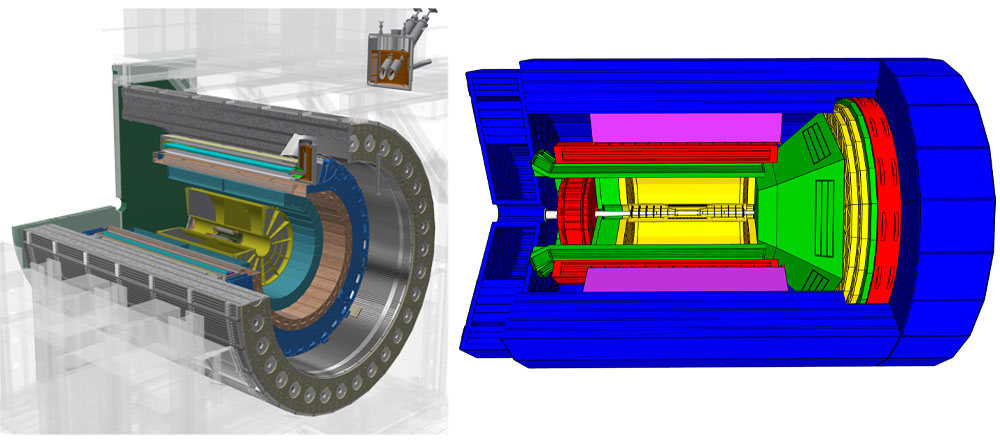Department of Energy Announces $5.7 Million for Research on Artificial Intelligence and Machine Learning (AI/ML) for Nuclear Physics Accelerators and Detectors
Projects will advance understanding of atomic structure and the nature of matter and antimatter
December 3, 2021
 enlarge
enlarge
Schematic for the sPHENIX detector at the Relativistic Heavy Ion Collider (left) and a preliminary concept for a future Electron-Ion Collider detector (right).
The following news release was issued by the U.S. Department of Energy (DOE). One of the projects receiving funding is aimed at developing intelligent experiments through real-time artificial intelligence (AI) to achieve fast data processing and autonomous detector control for the sPHENIX detector at the Relativistic Heavy Ion Collider (RHIC) — a DOE Office of Science user facility at DOE’s Brookhaven National Laboratory — and for future detectors at the Electron-Ion Collider (EIC). Another project will support AI-driven detector design for the EIC. Both AI projects will be led by scientists at other DOE laboratories and universities across the U.S.
WASHINGTON, D.C. - Today, the U.S. Department of Energy (DOE) announced $5.7 million for six projects that will implement artificial intelligence methods to accelerate scientific discovery in nuclear physics research. The projects aim to optimize the overall performance of complex accelerator and detector systems for nuclear physics using advanced computational methods.
“Artificial intelligence has the potential to shorten the timeline for experimental discovery in nuclear physics,” said Timothy Hallman, DOE Associate Director of Science for Nuclear Physics. “Particle accelerator facilities and nuclear physics instrumentation face a variety of technical challenges in simulations, control, data acquisition, and analysis that artificial intelligence holds promise to address.”
The six projects will be conducted by nuclear physics researchers at five DOE national laboratories and four universities. Projects will include the development of deep learning algorithms to identify a unique signal for a conjectured, very slow nuclear process known as neutrinoless double beta decay. This decay, if observed, would be at least ten thousand times more rare than the rarest known nuclear decay and could demonstrate how our universe became dominated by matter rather than antimatter. Supported efforts also include AI-driven detector design for the Electron-Ion Collider accelerator project under construction at Brookhaven National Laboratory that will probe the internal structure and forces of protons and neutrons that compose the atomic nucleus.
The projects are supported by the DOE Office of Science Nuclear Physics Program. Awards were selected by competitive peer review. Total planned funding is $5.7 million, with $3.2 million in Fiscal Year 2021 dollars and outyears funding contingent on congressional appropriations. The list of projects and more information can be found here.
2021-19292 | INT/EXT | Newsroom









